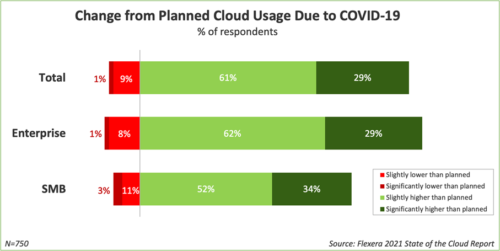State of cloud report – Many ITAM teams still not managing IaaS
ITAM and IaaS: Better together

Multi Cloud Hydra: Flexera’s state of cloud report found that 92% of organisations are using multi-cloud…but only 33% are using multi-cloud management tools. Image Credit
Flexera recently released their “State of Cloud 2021” report and, ahead of our webinar diving into more detail on May 27th, I want to take a look at some of the key stats and messages and what they can tell us about the Infrastructure as a Service (IaaS) market and how/why ITAM can get involved.
State of cloud report – Where are we right now?
A common trend I see in my everyday conversations is that many ITAM/SAM professionals are not engaged with IaaS, and this is reflected among Flexera’s survey respondents. I believe that IaaS represents a potential point of divergence when it comes to asset management – we’re seeing the majority of organisations are putting cloud management in the hands of almost anyone but ITAM. While many elements of IaaS cloud are new, there are still significant parts where ITAM (and procurement) have vast amounts of existing experience including:
- License compliance
- Inventory and discovery
- Vendor management
- Contract negotiation
But organisations don’t seem to be recognising this.
For example, when asked “Who is managing cloud?” across nine different areas, the best performance for ITAM was in “Governing software licenses in IaaS” where 9% of respondents said ITAM/SAM were responsible. That means within 91% of the organisations surveyed, someone other than the team with huge experience in managing software licenses is managing software licenses!
Plus, as I’ve said before, dealing with the various different cloud resources and types isn’t that dissimilar to the seemingly infinite amount of on-premises license types and metrics.
To the CIO of most organisations, cloud is seen as strategic to the current and future success of the business and so, in my opinion, being part of cloud’s success is going to be a key part of ITAM’s success over the next 5 – 10 years.
Cloud continues to grow
31% of the enterprises (organisations over 1000 seats) that responded are spending over $12 million per year on public cloud and, perhaps not surprisingly, optimizing this spend was listed as the top initiative.
That’s a huge amount of spend that is becoming more and more common and any amount of preventable waste is a significant problem for an organisation – and an opportunity for ITAM.
Accelerated by COVID-19

An ongoing process
“Painting the Forth bridge” is a British phrase (I’d love to learn some international equivalents) which refers to a job that is never done. The bridge required regular painting but, back in 2011, a new coating was applied and now it only needs to be painted ever 20 years or so – meaning they no longer need a permanent crew of painters.
A more apt, and certainly more global, phrase may well be “managing IaaS cloud costs”.
Cloud spend is continuing to grow; the number of organisations spending over $12 million annually increased by 80% in 2021. The ever changing, fluid nature of public cloud means there is always the opportunity for cloud spend to be better managed such as:
- The cloud provider makes changes to their technology or services
- The cloud provider makes changes to their management capabilities
- The cloud provider makes changes to their pricing structures
- Your organisation starts using new technology or services
- Your organisation changes the way it uses existing technology or services
- Your organisation migrates additional workloads into the cloud
All of these can mean that wasted spend will increase or that new techniques to enhance spend efficiency will occur. No matter where your organisation is in its cloud journey, the chance to get involved with cost management is always there.
Multi-cloud
Multi-cloud is where organisations use more than one public cloud i.e. Amazon AWS + Google Cloud Platform. I wrote an article last year that looked at some of the reasons organisations do this and some of the dangers it can bring for governance, licensing, and cost management – you can check it out here.
Flexera’s report found that 92% of organisations are using multi-cloud…but only 33% are using multi-cloud management tools. A gap like this suggests these organisations are either managing each cloud in its own silo or they’re not managing their cloud environments at all – both of which present challenges.
Centralisation of cloud
75% of respondents reported having a central cloud team such as a Cloud Centre of Excellence (CCoE) or a FinOps team. A key theme I see is the relationship between these cloud-focused teams and existing ITAM teams. If a newly created cloud team isn’t working hand-in-hand with the ITAM team, this can lead to problems such as:
- Missed opportunities for savings and optimisation
- Security gaps
- Roadmap uncertainty
- Overall lack of clarity
- License non-compliance
Which will negatively impact the business and how its ability to achieve the strategic goals set out by the CIO.
From a more tactical perspective, if on-premises licenses are being used in cloud environments (which they almost certainly are), that should absolutely be managed by ITAM. At any given time, your organisation needs to know:
- What licenses are being used?
- In what quantities?
- What license rules apply?
- Do those rules differ between cloud providers?
- How do those rules impact a proposed solution design?

As software vendors begin to perform audits within customer’s cloud environments, the ability to prevent non-compliance penalties will be key.
Stakeholder engagement
It’s far from a new topic but stakeholder engagement is key in the hybrid world. There are some things ITAM are better at and there are some things that the Cloud team are better at – the goal is for everyone recognise each other’s value and collaborate accordingly. This includes ITAM, Security, FinOps, Procurement, Finance, Architects, and Infrastructure – plus I’m sure there are other teams within your organisation that should be included too.
As mentioned previously, various other parts of the organisation are responsible for managing cloud – including software licenses, chargeback, governance and more – but ask yourself…do they want to be doing that? For areas that are clearly a better fit under ITAM, reach out to those responsible and offer your help and advice. In an ideal world, you’ll be able to ensure things are done correctly and in line with your existing procedures AND build/strengthen internal relationships – both of which are invaluable.
State of cloud report – Conclusion
Actively getting involved with IaaS management can be a great way to challenge the historic misunderstanding of ITAM that exists within many organisations and to help drive ITAM into the future. Public cloud underpins so many parts of an organisation’s infrastructure and is key to so many C-level goals and objectives, that it’s critical it is managed correctly.
While there will always be on-premises technology, much of the future is based in the cloud – Open Source, Internet of Things, Industry Clouds, Digital Twins, Connected Cities, Machine Learning, Artificial Intelligence – so figuring out your place, and ITAM’s place, in that world now will benefit everyone in the long-run.
- To hear more of my thoughts on this subject, register for the Flexera webinar here: Get your head in the cloud: ITAM & IaaS
- And also register for our North American Wisdom Online conference here: Wisdom Online North America 2021
- Tags: cloud · Cloud Cost Management · IaaS · ITAM · Public Cloud · Stakeholder Engagement
About Rich Gibbons
A Northerner renowned for his shirts, Rich is a big Hip-Hop head, and loves travel, football in general (specifically MUFC), baseball, Marvel, and reading as many books as possible. Finding ways to combine all of these with ITAM & software licensing is always fun!
Connect with Rich on Twitter or LinkedIn.
